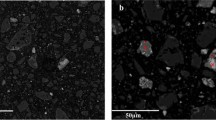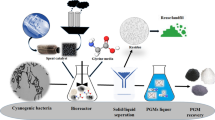Abstract
Platinum group metals (PGMs), especially Pd, Pt, and Rh, have drawn great attention due to their unique features. Direct separation of Pd and Pt from highly acidic automobile catalyst leach liquors is disturbed by various factors. This work investigates the effect of various parameters including the acidity, extractant concentration, phase ratio A/O, and diluents on the Pd and Pt extraction and their stripping behaviors. The results show that the Pd and Pt are successfully separated from simulated leach liquor of spent automobile catalysts with monothio-Cyanex 272 and trioctylamine (TOA). Monothio-Cyanex 272 shows strong extractability and specific selectivity for Pd, and only one single stage is needed to recover more than 99.9% of Pd, leaving behind all the Pt, Rh, and base metals of Fe, Mg, Ce, Ni, Cu, and Co in the raffinate. The loaded Pd is efficiently stripped by acidic thiourea solutions. TOA shows strong extractability for Pt and Fe at acidity of 6 mol·L−1 HCl. More than 99.9% of Pt and all of the Fe are extracted into the organic phase after two stages of countercurrent extraction. Diluted HCl easily scrubs the loaded base metals (Fe, Cu, and Co). The loaded Pt is efficiently stripped by 1.0 mol·L−1 thiourea and 0.05–0.1 mol·L−1 NaOH solutions. Monothio-Cyanex 272 and TOA can realize the separation of Pd and Pt from highly acidic leach liquor of spent automobile catalysts.
Similar content being viewed by others
References
H. Pal and V. Sharma, Mechanical, electrical, and thermal expansion properties of carbon nanotube-based silver and silver-palladium alloy composites, Int. J. Miner. Metall. Mater., 21(2014), No. 11, p. 1132.
V. Nikolic, Z. Kamberovic, Z. Andic, M. Korac, M. Sokic, and V. Maksimovic, Influences of synthesis methods and modifier addition on the properties of Ni-based catalysts supported on reticulated ceramic foams, Int. J. Miner. Metall. Mater., 21(2014), No. 8, p. 806.
China Industry Information, Development trend of supply and demand of platinum in China in 2019: Hydrogen energy is expected to drive the demand for platinum continuously, (2020-03-02) [2021-08-04]. http://www.chyxx.com/industry/202003/838942.html.
China Industry Information, Development trend of palladium supply and demand in China in 2019: The sixth national standard increases the amount of palladium used in fuel vehicles, (2020-03-02) [2021-08-04]. http://www.chyxx.com/industry/202003/838922.html.
China Economic Information Network, The global rhodium supply and demand relationship continues to be tense: rhodium recovery and reuse is of great significance under the pressure of environmental protection, (2020-06-28) [2021-08-04]. https://www.huaon.com/channel/trend/626256.html.
C. Saguru, S. Ndlovu, and D. Moropeng, A review of recent studies into hydrometallurgical methods for recovering PGMs from used catalytic converters, Hydrometallurgy, 182(2018), p. 44.
D.J. de Aberasturi, R. Pinedo, I.R. de Larramendi, J.I. Ruiz de Larramendi, and T. Rojo, Recovery by hydrometallurgical extraction of the platinum-group metals from car catalytic converters, Miner. Eng., 24(2011), No. 6, p. 505.
A.M. Yousif, Recovery and then individual separation of platinum, palladium, and rhodium from spent car catalytic converters using hydrometallurgical technique followed by successive precipitation methods, J. Chem., 2019(2019), art. No. 2318157.
S.J. Liu, Mining and Metallurgy of Platinum Group Metals, Metallurgy Industry Press, Beijing, 2001.
M. Hasani, A. Khodadadi, S.J. Koleini, A.H. Saeedi, Y. Perez-Pacheco, and A.M. Melendez, Platinum leaching from automotive catalytic converters with aqua regia, J. Phys. Conf. Series., 786(2017), art. No. 012043.
J. Gong, Y.J. Wang, W. Kong, et al., Extraction of palladium from waste catalytic converters, Chin. J. Precious Met., 39(2018), No. S1, p. 155.
B.R. Reddy, B. Raju, J.Y. Lee, and H.K. Park, Process for the separation and recovery of palladium and platinum from spent automobile catalyst leach liquor using LIX 84I and Alamine 336, J. Hazard. Mater., 180(2010), No. 1–3, p. 253.
C. Nowottny, W. Halwachs, and K. Schügerl, Recovery of platinum, palladium and rhodium from industrial process leaching solutions by reactive extraction, Sep. Purif. Technol., 12(1997), No. 2, p. 135.
P. Malik and A.P. Paiva, A novel solvent extraction route for the mutual separation of platinum, palladium, and rhodium in hydrochloric acid media, Solvent Extr. Ion Exch., 28(2010), No. 1, p. 49.
O. Ortet and A.P. Paiva, Liquid-liquid extraction of palladium(II) from chloride media by N, N′-dimethyl-N, N′-di-cyclohexylthiodiglycolamide, Sep. Purif. Technol., 156(2015), p. 363.
K. Senthil, U. Akiba, K. Fujiwara, F. Hamada, and Y. Kondo, New heterocyclic dithioether ligands for highly selective separation and recovery of Pd(II) from acidic leach liquors of spent automobile catalyst, Ind. Eng. Chem. Res., 56(2017), No. 4, p. 1036.
M. Yamada, M.R. Gandhi, U.M.R. Kunda, T. Mori, K. Haga, and A. Shibayama, Recovery of Pd(II) from leach solutions of automotive catalysts by solvent extraction with new thiophosphate extractants, Hydrometallurgy, 191(2020), art. No. 105221.
S.P. Feng and K. Huang, Enhanced separation of Pd(II) and Pt(IV) from hydrochloric acid aqueous solution using 2-((2-methoxyethyl)thio)-1H-benzimidazole, Rare Met., 39(2020), No. 12, p. 1473.
O. Ortet and A.P. Paiva, Development of tertiary thioamide derivatives to recover palladium(II) from simulated complex chloride solutions, Hydrometallurgy, 151(2015), p. 33.
M.R. Gandhi, M. Yamada, K. Haga, and A. Shibayama, Synthesis of pincer-type extractants for selective extraction of palladium from PGMs: An improved liquid-liquid extraction approach to current refining processes, Sci. Rep., 7(2017), art. No. 8709.
M. Yamada, Y. Kaneta, M.R. Gandhi, U.M.R. Kunda, and A. Shibayama, Recovery of Pd(II) and Pt(IV) from leach liquors of automotive catalysts with calixarene-based di-n-alkylamino extractants in saturated hydrocarbon diluents, Hydrometallurgy, 184(2019), p. 103.
R.E.C. Torrejos, G.M. Nisola, S.H. Min, J.W. Han, S.P. Lee, and W.J. Chung, Highly selective extraction of palladium from spent automotive catalyst acid leachate using novel alkylated di-oxadithiacrown ether derivatives, J. Ind. Eng. Chem., 89(2020), p. 428.
M.L. Firmansyah, F. Kubota, W. Yoshida, and M. Goto, Application of a novel phosphonium-based ionic liquid to the separation of platinum group metals from automobile catalyst leach liquor, Ind. Eng. Chem. Res., 58(2019), No. 9, p. 3845.
J.Y. Lee, B. Raju, B.N. Kumar, J.R. Kumar, H.K. Park, and B.R. Reddy, Solvent extraction separation and recovery of palladium and platinum from chloride leach liquors of spent automobile catalyst, Sep. Purif. Technol., 73(2010), No. 2, p. 213.
T.H. Nguyen, B.N. Kumar, and M.S. Lee, Selective recovery of Fe(III), Pd(II), Pt(IV), Rh(III) and Ce(III) from simulated leach liquors of spent automobile catalyst by solvent extraction and cementation, Korean J. Chem. Eng., 33(2016), No. 9, p. 2684.
S. Harjanto, Y.C. Cao, A. Shibayama, et al., Leaching of Pt, Pd and Rh from automotive catalyst residue in various chloride based solutions, Mater. Trans., 47(2006), No. 1, p. 129.
J.L. Wang, W. Xu, H. Liu, F.S. Yu, and H.J. Wang, Extractant structures and their performance for palladium extraction and separation from chloride media: A review, Miner. Eng., 163(2021), art. No. 106798.
J.Y. Yang and D.X. Liu, Solvent Extraction, Metallurgy Industry Press, Beijing, 1988.
M.L. Firmansyah, F. Kubota, and M. Goto, Selective recovery of platinum group metals from spent automotive catalysts by leaching and solvent extraction, J. Chem. Eng. Jpn, 52(2019), No. 11, p. 835.
Acknowledgements
This work was financially supported by the National Key Research and Development Program for Young Scientists, China (No. 2021YFC2901100). We are very grateful to Peilong Wang and Chengyan Xu for metal ion determination with ICP-OES.
Author information
Authors and Affiliations
Corresponding authors
Additional information
Conflict of Interest
We declare that we have no known competing financial interests or personal relationships that could have appeared to influence the work reported in this paper.
Rights and permissions
About this article
Cite this article
Wang, J., Liu, L., Xu, W. et al. Separation of Pd and Pt from highly acidic leach liquor of spent automobile catalysts with monothio-Cyanex 272 and trioctylamine. Int J Miner Metall Mater 30, 877–885 (2023). https://doi.org/10.1007/s12613-022-2492-6
Received:
Revised:
Accepted:
Published:
Issue Date:
DOI: https://doi.org/10.1007/s12613-022-2492-6




